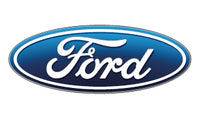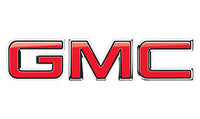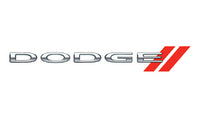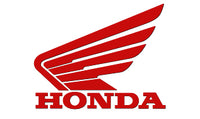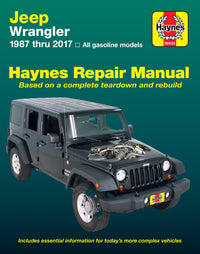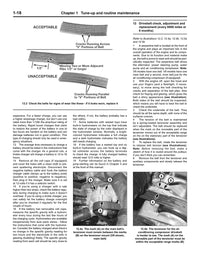All Haynes Digital Online Manuals feature everything you love about our books in an instantly accessible digital online form, including the procedure we focus on here, an engine oil and filter change on the 2008-2018 Dodge Grand Caravan (including Caravan Cargo) and Chrysler Town & Country mini vans with 3.3, 3.6, 3.8 or 4.0 liter V6 engines.
This page is taken directly from our online manual 30014.
These tools are required when changing the engine oil and filter
1) Drain pan - It should be fairly shallow in depth to make it easy to slide under the car, but wide to prevent spills
2) Rubber gloves - When removing the drain plug and filter, you will likely get oil on your hands
3) Breaker bar - Sometimes the oil drain plug is tight, and a long breaker bar is needed to loosen it
4) Socket - Sized correctly for the drian plug, to be used with the breaker bar or a ratchet - six-point preferred
5) Filter wrench - This is a metal band-type filter wrench, which requires clearance around the filter to be effective
6) Filter wrench - This is like a giant socket and fits on the bottom of the filter, to be turned with a ratchet or breaker bar

Draining the oil
Frequent oil changes are the best preventive maintenance the home mechanic can give the engine, because aging oil becomes diluted and contaminated, which leads to premature engine wear.
Make sure you have all the necessary tools before you begin this procedure. You should also have plenty of rags or newspapers handy for mopping up any spills.
Access to the underside of the vehicle is greatly improved if the vehicle can be driven onto ramps, or jacked up and supported by jack stands.
If this is your first oil change, look under the vehicle and familiarize yourself with the locations of the oil drain plug and the oil filter. The engine and exhaust components will be warm during the actual work, so try to anticipate any potential problems that will cause.
Start the engine and allow it to reach its normal operating temperature. Warm oil and sludge will flow out more easily. When the engine is warm, park the vehicle on a level spot and turn off the engine. Open the hood and remove the filler cap from the valve cover.
(On the 3.6 liter engine, the filler cap must be removed to drain all the oil. On other engines it will help the oil drain faster)Raise the vehicle with a floor jack and support it securely on jack stands.
Warning: Never get beneath the vehicle when it is supported only by a jack. The jack provided with your vehicle is designed solely for raising the vehicle to remove and replace the wheels. Always use jackstands to support the vehicle when it becomes necessary to place your body underneath the vehicle.
- (See illustration) Place the drain pan under the drain plug in the bottom of the engine oil pan and remove the plug, being careful not to touch the hot exhaust components. You may want to wear gloves while unscrewing the plug to to keep the hot oil off your skin.
Use a proper size box-end wrench or socket to remove the oil drain plug and avoid rounding it off.

- Allow the old oil to drain into the pan. It may be necessary to move the pan farther under the engine as the oil flow slows to a trickle. Inspect the old oil for the presence of metal shavings and chips.
- After all the oil has drained, wipe off the drain plug with a clean rag. Even minute metal particles clinging to the plug would immediately contaminate the new oil.
- Clean the area around the drain plug opening, reinstall the plug and tighten it to the proper torque:
All V6 engines 20 ft-lbs (do not over tighten) - Move the drain pan into position under the oil filter.
Removing the oil filter - 3.3L, 3.8L and 4.0L V6 engines
(For the 3.6 liter V6 engine skip ahead to step 16)
- (See Illustration) Loosen the oil filter by turning it counterclockwise with an oil filter wrench. Once the filter is loose, use your hands to unscrew it from the block. Keep the open end pointing up to prevent the oil inside the filter from spilling out.
Use an oil filter wrench to remove the filter (3.3L, 3.8L and 4.0L V6 engines)
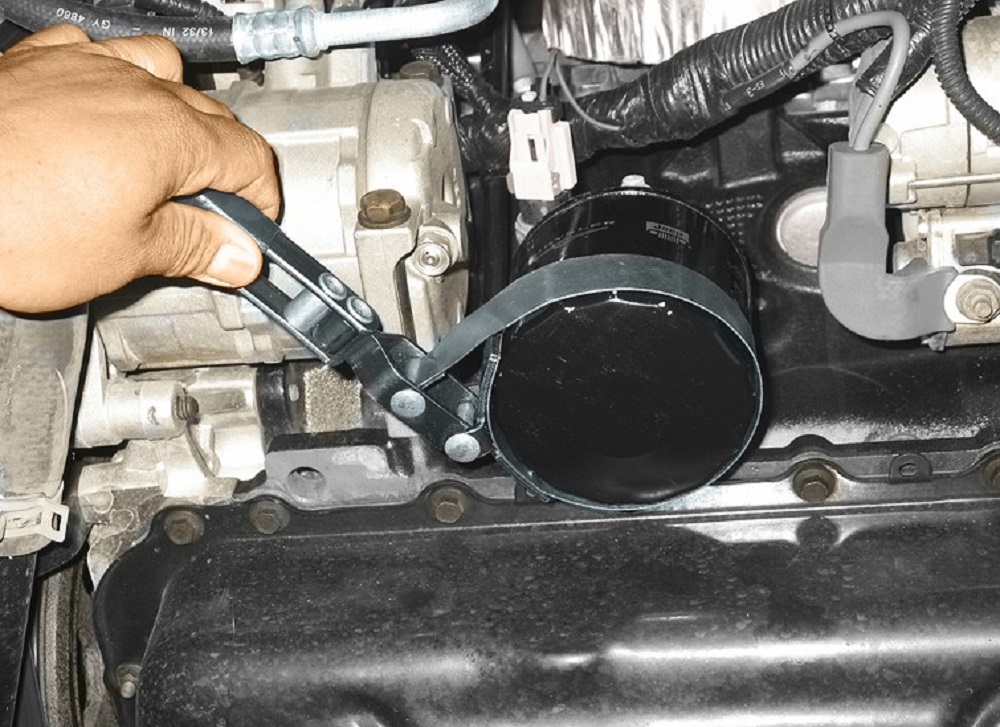
- With a clean rag, wipe off the mounting surface on the block. If a residue of old oil remains, it will cause smoke when the block is heated up. Also make sure that none of the old gasket remains stuck to the mounting surface. It can be removed with a scraper if necessary.
- (See Illustraion) Compare the old filter with the new one to make sure they are the same type. Smear some clean engine oil on the rubber gasket of the new filter.
Lubricate the oil filter gasket with clean engine oil before installing the filter on the engine.
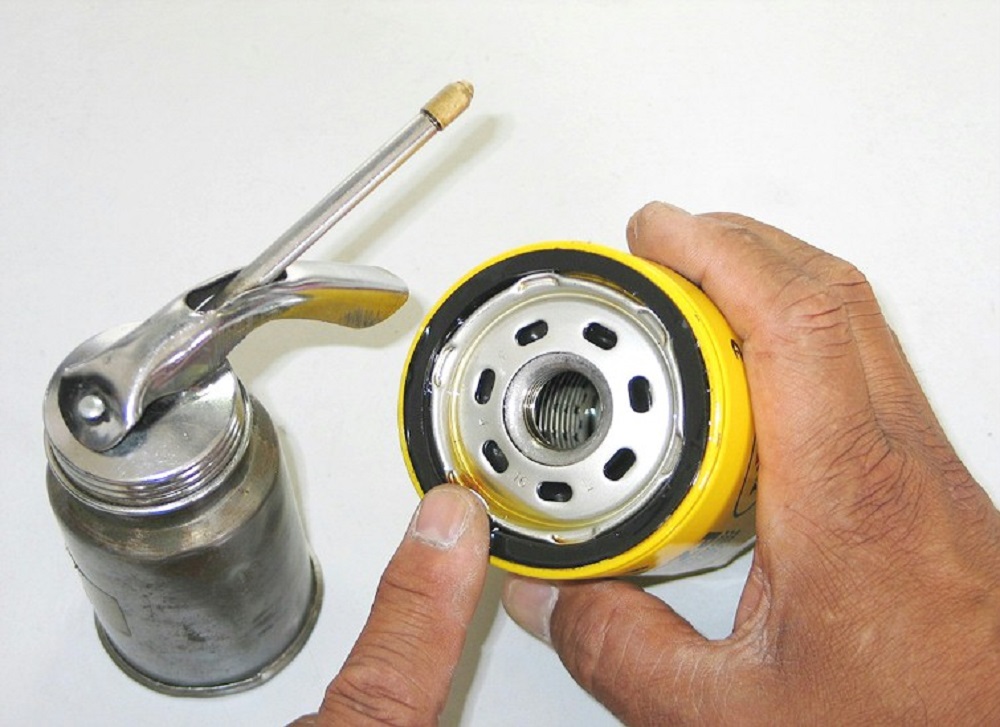
- Screw the new filter to the engine by hand, following the tightening directions printed on the filter canister or packing box - Typically, 3/4 to one full turn past the point where the filter gasket contacts the engine. Do not tighten with a filter wrench or you risk over tightening.
Removing the oil filter - 3.6 liter V6 engine
- Lift up on the outer edges of the engine cover to disengage the rubber mounts from the ballstuds, and remove the engine cover.
- (See illustration) Place a rag at the base of the filter housing, then loosen the filter cap by turning it counterclockwise.
Using a box end wrench or socket, turn the filter cap counterclockwise to remove it (3.6L V6 engine)

- Remove the cap and filter from the engine, then pull the filter out of the cap.
- Remove and discard the O-ring from the filter cap.
- (See illustration) Insert a new filter into the cap, making sure the filter clips lock into the cap.
Oil filter element and cap details - 3.6 liter V6 engine
The 3.6 liter V6 engine uses an oil filter element that drops in from the top of the engine.
1) Oil filter element 2) Oil filter clips
3) Oil filter cap 4) O-ring

Install a new O-ring onto the cap and apply a light amount of engine oil to the O-ring.
Place the filter assembly into the filter housing and carefully thread the cap into the housing. Tighten the cap to the proper torque:
36. liter V6 18 ft-lbs (do not over tighten)
All engines
Remove all tools, rags, etc. from under the vehicle, being careful not to spill the oil in the drain pan, then lower the vehicle.
Add new oil to the engine through the oil filler cap in the valve cover. Use a funnel, if necessary, to prevent oil from spilling onto the top of the engine. Pour four quarts of fresh oil into the engine. Wait a few minutes to allow the oil to drain into the pan, then check the level on the oil dipstick (see Section 4 ). If the oil level is at or near the FULL mark on the dipstick, install the filler cap, start the engine and allow the new oil to circulate.
Allow the engine to run for about a minute. While the engine is running, look under the vehicle and check for leaks at the oil pan drain plug and around the oil filter. If either is leaking, stop the engine and tighten the plug or filter.
Wait a few minutes to allow the oil to trickle down into the pan, recheck the level on the dipstick and, if necessary, add enough oil to bring the level to the FULL mark.
During the first few trips after an oil change, make it a point to check frequently for leaks and proper oil level.
The old oil drained from the engine cannot be reused in its present state and should be disposed of properly. Check with your local auto parts store, disposal facility or environmental agency to see if they will accept the oil for recycling. After the oil has cooled it can be drained into a sealable container for transport to one of these disposal sites. Do not dispose of the oil by pouring it on the ground or down a drain!
Oil change indicator light resetting
Note: It is possible that, driving under the best possible conditions, the oil life monitoring system may not indicate the oil needs to be changed. The manufacturer states that the oil and filter must be changed at least once every year and the oil life monitor reset. If the “Oil Change Required” message comes on when the vehicle is immediately restarted, the oil life monitor was not reset and the reset procedure must be done again. If the message is not reset, it will continue to show up each time you turn the ignition switch On or start the vehicle. It is possible to temporarily turn off the message by, pressing and releasing the “Menu” button.
- Turn the ignition key to the “ON” position but DO NOT start the engine.
- Depress the accelerator pedal all the way to the floor, three times within 10 seconds.
- Turn the ignition key to the “OFF” or “LOCK” position, then start the vehicle.
